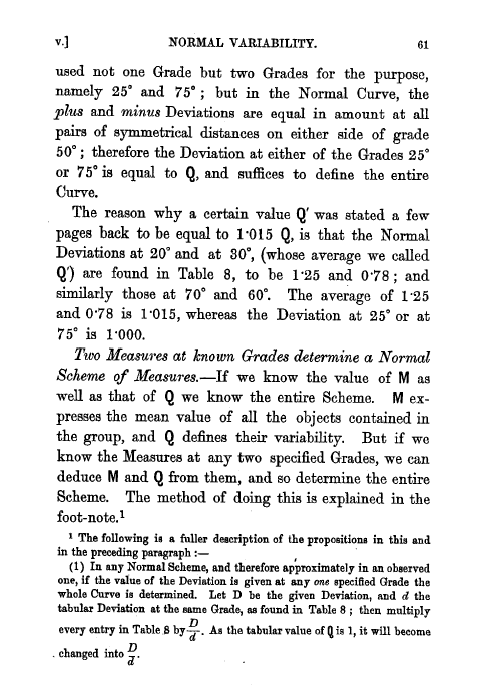V.] NORMAL VARIABILITY. 61
used not one Grade but two Grades for the purpose, namely 25° and 75° ; but in the Normal Curve, the plus and minus Deviations are equal in amount at all pairs of symmetrical distances on either side of grade 50'; therefore the Deviation at either of the Grades 25° or 75° is equal to Q, and suffices to define the entire Curve.
The reason why a certain value Q' was stated a few pages back to be equal to 1.015 Q, is that the Normal Deviations at 20° and at 30°, (whose average we called Q') are found in Table 8, to be 1.25 and 0.78 ; and similarly those at 70° and 60°. The average of 1.25 and 0.78 is 1.015, whereas the Deviation at 25° or at
75° is 1.000.
Two Measures at known Grades determine a Normal Scheme of Measures.-If we know the value of M as well as that of Q we know the entire Scheme. M expresses the mean value of all the objects contained in the group, and Q defines their variability. But if we know the Measures at any two specified Grades, we can deduce M and Q from them, and so determine the entire Scheme. The method of doing this is explained in the
foot-note.1
i The following is a fuller description of the propositions in this and in the preceding paragraph :
(1) In any Normal Scheme, and therefore approximately in an observed one, if the value of the Deviation is given at any one specified Grade the whole Curve is determined. Let D be the given Deviation, and d the tabular Deviation at the same Grade, as found in Table 8 ; then multiply
every entry in Table .$ by D . As the tabular value of Q is 1, it will become changed into D.

